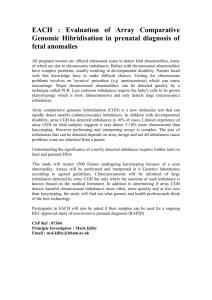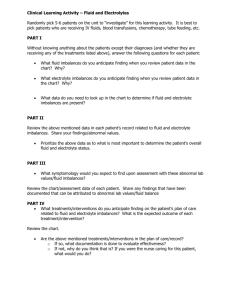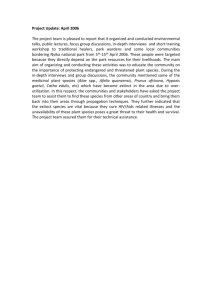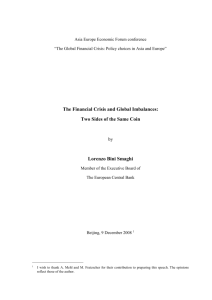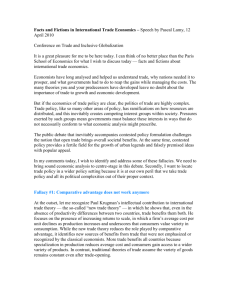DOC - Europa
advertisement
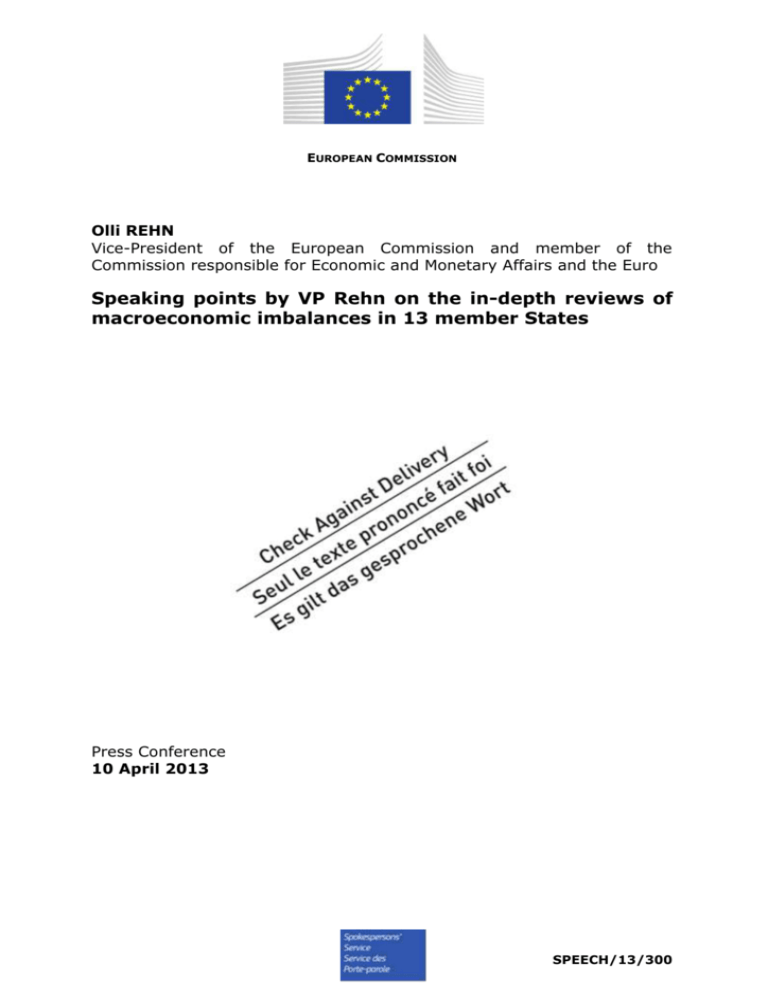
EUROPEAN COMMISSION Olli REHN Vice-President of the European Commission and member of the Commission responsible for Economic and Monetary Affairs and the Euro Speaking points by VP Rehn on the in-depth reviews of macroeconomic imbalances in 13 member States Press Conference 10 April 2013 SPEECH/13/300 Good afternoon. I will present today the findings of all together 13 in-depth reviews prepared by the Commission Services with the leadership of the Financial Affairs Directorate (DG ECFIN). This is in fact a key part of our reformed and reinforced economic governance. This is the second key pillar of the new economic governance. The first pillar is fiscal policy and the Excessive Deficit Procedure while the second pillar is the Macroeconomic Imbalances where we look at structural reforms, competitiveness and many other issues that underlie the health and resilience of the economies. These in-depth reviews are intended to serve as analytical raw material for the EU member States when they prepare their Stability and Reform programmes by the end of April. And this is also intended to serve as the analytic foundation of the country specific recommendations that the Commission will present on the 29th of May for these countries, and in fact for all 27 Member States. In a nutshell, the findings of this in-depth review serve as a necessary wake up call for several Member States to take decisive actions for restoring competitiveness and thus creating foundations for sustainable growth and job creation. Our transformed economic governance enables us to address macroeconomic imbalances pre-emptively and to create the foundations for sustainable growth. Decisive policy action by Member States and at EU-level is helping to rebalance the European economy. But significant challenges remain: it will take some time yet to complete the unwinding of the imbalances that were able to grow unchecked in the decade up to the crisis, and which continue to take a toll on our economies. The new governance tools are designed to help governments to pick up on underlying problems and address them without delay, pursuing country specific policies within a wider European framework. With the 2013 Annual Growth Survey last November we started the third cycle of the European Semester of economic policy coordination. As part of this process, in its Alert Mechanism Report, the Commission screened all Member States for possible macroeconomic imbalances. This was done on the basis of a scoreboard of indicators as part of the Macroeconomic Imbalances Procedure. I will present today the findings of the 13 in-depth reviews. First I will focus on the underlying economic trends, before turning to specific findings and the way forward. The current account is one of the key variables for our in-depth analyses. While current account surpluses should be a sign also reflect market failures or a weakness of opportunities. The macro-economic imbalances misallocation of resources in surplus countries with of healthy competitiveness, they can domestic demand and investment observed in the EU resulted in a negative implications for growth. The adjustment of external positions is proceeding in many countries and in the euro area as a whole. For the deficit countries, it shows the dampening effects on demand as the inevitable unwinding of high debt levels proceeds and thus imports are reduced. But deficit countries have also experienced a rise in exports thanks to gains in competitiveness. We expect this trend to continue. You can see that the current account of the euro area as a whole is moving into surplus. Some countries, like Portugal, have been able to broaden their export base to non-EU countries. Also the current account in Spain is moving into surplus. In the Netherlands the current account surplus may increase, reflecting both a competitive and export2 oriented economy, but the housing market now contracts domestic demand in the country. Finland, in contrast, now belongs to the group of "former surplus countries" and is alone in this group, since Finland turned to deficit in 2011. In some cases, the current account deficits were financed with debt. This happened in Spain, where the housing boom was ultimately and extensively and excessively financed with credit from abroad. In other cases, like the catching-up economies of Bulgaria and Hungary, current account deficits were a reflection of foreign direct investment, which can be a good sign in that kind of circumstance. Slovenia, also a catching-up country, has not accumulated high foreign liabilities, but was also not able to attract much foreign direct investment either. The current account programmes accumulated over a long period, a decade, and it will take time to fully reverse them, even if the process of rebalancing is under way. Most EU Member States have seen their goods export market shares decline in the global markets while those of emerging economies have risen. As a result, the EU Member States are losing relative weight and market power in world trade. However, inside the EU there have been large differences. Losses in export market shares have been particularly severe in the UK, France, Italy and Finland. For Hungary and Slovenia, exports were very dynamic, as in other catching-up economies of Eastern and Central Europe, but they have also lost in dynamism in recent years in terms of export market shares. For Spain, exports have held up well, and recent developments are quite encouraging. However, the share of exports in Spain's GDP [32%] is well below the EU average [45 %] not to speak of Germany's [over 50% of GDP]. This relatively low level of exports reflects the dominance of consumption-fuelled growth in Spain before the crisis. Another key indicator for competitiveness is unit labour costs. Though there has been clear progress in unit labour cost convergence, the adjustment in labour markets is not complete. Competitiveness losses accumulated over many years, have not yet been fully recovered. In a number of countries the adjustment will have to continue through wage moderation as structural reforms proceed. At the same time, the more dynamic job developments that we are seeing in the surplus countries, not least in Germany, will contribute to the rebalancing of the euro area economy in its entirety. While the in-depth reviews approach countries from a common set of economic indicators, this is not a mechanical exercise. The challenges differ from country to country our quantitative analysis is complemented by qualitative analysis in these indepth reviews. 3 However, there are a number of common themes and the first one is. 1. Structural reforms support growth and job creation, which in turn will reduce pressures on public finances. But this often takes time. That is why a credible mediumterm fiscal strategy and a comprehensive set of structural reforms complement each other. 2. External adjustment is clearly proceeding and needs to continue and in some countries intensify. 3. In some countries, price and non-price competitiveness remain crucial concerns. 4. Housing markets are still adjusting. 5. Debt levels of households, companies and governments are still high on average in Europe, but are being reduced. This deleveraging is necessary, even if it inevitably dampens growth in the short-term. Now, what do we draw as conclusions from these in-depth reviews at this stage? I want to underline and remind you that we are indeed making the country specific recommendations at the end of May. These in-depth reviews are intended as policy making raw material for Member States who have imbalances and they give some general conclusion, indications at this stage but we will make a more profound assessment once we get Stability and Reform programmes from the Member States by early May. On that basis we will make the country specific recommendations. Based on the in-depth reviews and in line with the agreed rules, the Commission assesses whether a country has no imbalances or it has imbalances and whether these are excessive. Overall, we found that in all these 13 countries there are imbalances of different kinds. Let me highlight two cases in particular. In Slovenia, while in a still manageable position, excessive macroeconomic imbalances are quickly building up. In order to halt and reverse this negative trend, Slovenia needs now to proceed swiftly and decisively. It should complete the reforms it has started and include comprehensive and concrete policy measures in its forthcoming National Reform Programme and Stability Programme to be presented to the Commission in the coming weeks. In Spain, despite significant progress in 2012, there are still excessive macroeconomic imbalances. Spain should therefore maintain the reform momentum by including comprehensive and concrete policy measures in its forthcoming Stability and reform Programmes. As I said, the Commission works in partnership with both the governments, as well as with other governments. We want to support these countries in their reform efforts and once we have the Stability and Reform programmes at our disposal, we will present our assessment, by the end of May. On 29th of May, for all Member States we will present our assessment of the budgetary and reform plans and come forward with concrete country-specific recommendations for each and every Member States. 4 In this context, we will also consider whether further steps are needed for those Member States with excessive imbalances. At that time we will also reassess the situation under the on-going excessive deficit procedures and, where necessary, adopt the appropriate recommendations to the Council and then to the Member States, focusing as ever on the structural sustainability public finances over the medium-term in the Member States. This approach again underlines what I said before: Structural reforms to enhance sustainable growth and job creation and a sound fiscal policy go hand in hand complement each other. Thank you. 5


